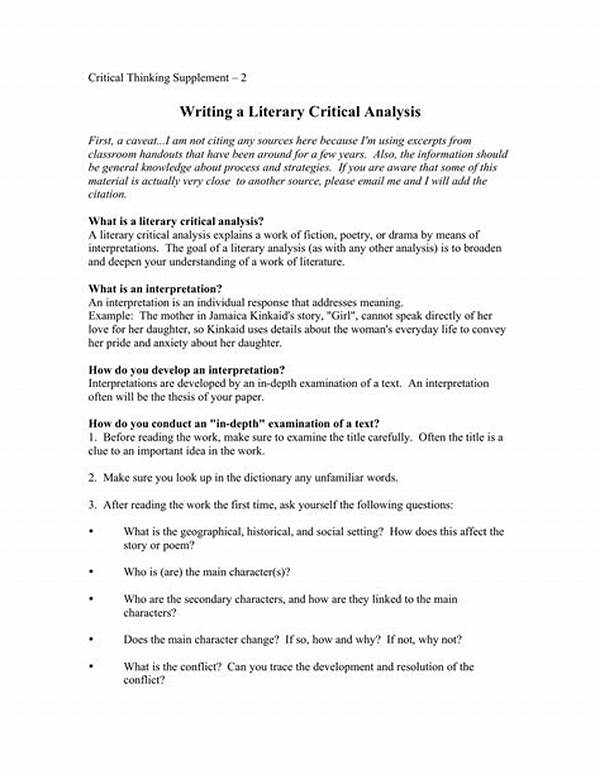The practice of critically analyzing literature sources entails a systematic examination of texts to evaluate their validity, significance, and contribution. This process is crucial in validating information and ensuring robust academic or research work. By meticulously reviewing literature, one can uncover biases, identify limitations, and understand the broader context. A thorough critical analysis enables scholars and researchers to build upon existing knowledge confidently and construct well-informed arguments. Moreover, it aids in recognizing the methodological soundness of a study and assessing the reliability and credibility of sources. Thus, engaging in critical analysis of literature sources is an indispensable component to maintaining integrity in scholarly work and fostering intellectual advancement.
Read Now : Database Performance Tuning Methods
The Importance of Evaluating Literature Critically
Critical analysis of literature sources is integral in discerning the reliability of information. Through this process, scholars assess the relevance of material in supporting research objectives. Evaluating literature critically involves examining the methodology used in studies, the objectivity of the authors, and the consistency of the arguments presented. It requires a skeptical, yet open-minded approach to comprehend the implicit and explicit meanings conveyed by the text. Furthermore, critical analysis of literature sources provides an opportunity to explore diverse perspectives, uncovering insights that reinforce or challenge existing paradigms. This analytical practice ensures scholarly discourse remains rigorous and progressive, moving fields of study toward innovation and deeper understanding.
Steps in Conducting a Critical Analysis of Literature Sources
1. Identify the Purpose: When engaging in critical analysis of literature sources, begin by understanding the primary objective of the text. Assess the author’s aims and determine if they align with your research goals.
2. Evaluate the Methodology: Examine the methods employed in the study. Assess whether they are suitable, well-justified, and effectively addressed the research questions.
3. Assess the Credibility: Consider the qualifications and affiliations of the authors to determine the reliability of the source.
4. Analyze the Arguments: Scrutinize the logic and coherence of the arguments presented. Identify any assumptions, biases, or inconsistencies.
5. Contextual Understanding: Place the literature in a broader context to evaluate its contribution to the field and its relationship with other works.
Elements of Effective Critical Analysis
Conducting a critical analysis of literature sources involves various components that ensure a comprehensive evaluation. Firstly, a robust analysis requires comprehension of the source material, enabling the identification of key arguments and underlying assumptions. Secondly, attention to detail is essential; an effective critique hinges on recognizing nuanced insights and discrepancies within the text. Thirdly, context plays a pivotal role in establishing the relevance and impact of the work. Analyzing literature necessitates an understanding of historical and current dialogues within the discipline to appraise the source’s significance. Lastly, engaging with diverse perspectives enriches the analysis, promoting a balanced examination that acknowledges the complexity and multifaceted nature of most academic subjects.
Challenges in Conducting Critical Analysis
1. Bias Recognition: One of the challenges in the critical analysis of literature sources is identifying personal and publication biases that may affect interpretations.
2. Comprehension: Achieving a thorough understanding of complex material is often a demanding task.
3. Resource Availability: Limited access to comprehensive resources may hinder a complete evaluation of literature.
4. Time Constraints: Rigorous analysis is time-intensive and requires a dedication often constrained by deadlines.
Read Now : Soil Moisture Estimation With Ai
5. Balancing Perspectives: Striking a balance between different viewpoints can be challenging and requires careful scrutiny.
6. Data Interpretation: The complexity of interpreting data accurately within its context presents an ongoing challenge.
7. Evolving Literature: Continuous advancements in research fields necessitate regular updating of one’s analytical perspectives.
8. Analytical Skills: Developing critical thinking and analytical skills takes considerable effort and practice.
9. Interdisciplinary Overlap: Literature that intersects multiple disciplines can complicate analysis due to varying methodologies.
10. Synthesis of Information: Combining insights from multiple sources into a coherent analysis demands skill and precision.
Strategies for Effective Critical Analysis
Engaging effectively in the critical analysis of literature sources involves multiple strategic approaches. Firstly, methodical organization is crucial. Establishing a structured framework for reviewing sources ensures clarity in evaluation. Secondly, nurturing analytical acumen through continual practice enhances one’s ability to delve deeply into textual content. Furthermore, employing a critical mindset—questioning assumptions and seeking evidence—forms the backbone of a strong analysis process. Moreover, adopting a comparative approach, contrasting various sources, enriches the critique. Another pivotal strategy includes authoring summaries or annotations, which facilitate the distillation of complex ideas. Collaboration with peers, through discussions or reviews, also serves as a valuable method to garner diverse insights, further sharpening one’s evaluative capabilities.
Conclusion
In conclusion, the critical analysis of literature sources stands as a fundamental pillar within academic and research endeavors. It ensures the credibility and validity of scholarly work. By diligently scrutinizing the design, methodology, and arguments of literature, one can draw meaningful insights that propel academic discourse forward. Moreover, this analytical practice affords scholars the opportunity to contribute to a dynamic and multifaceted body of knowledge, crucial for both theoretical and practical advancements. Critical analysis not only enriches individual understanding but also serves as a collective endeavor, fostering progress across diverse disciplines and nurturing an informed global society.
The Ongoing Necessity of Critical Analysis
The critical analysis of literature sources remains a persisting, essential component of scholarly work. In an era where information is abundant and readily accessible, discernment in choosing credible and valuable sources is critical. By engaging in this analytical practice, scholars enhance their work’s depth and rigor, ensuring that their contributions remain timely and impactful. As such, critical analysis not only supports the individual pursuit of knowledge but also plays a significant role in the collective advancement of academic inquiry and innovation across the spectrum of human understanding.
